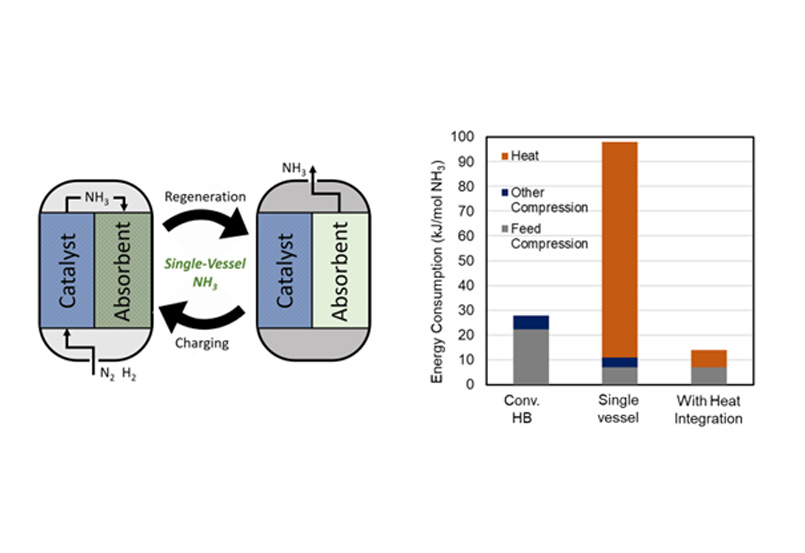Background
Ammonia is the second-largest globally produced chemical (~ 240 million tons/year), mainly used as fertiliser, feeding over 50% of the World’s population. Currently, (brown/grey) ammonia is produced through the Haber Bosch process using fossil fuels as a source of energy and feedstock, responsible of ~ 1.8% global CO2 emissions (~ 40% of the primary chemical industry).
The replacement of traditional (“brown/grey”) ammonia by green ammonia, made exclusively using renewable energy, hydrogen from water and nitrogen from air, has the potential to decarbonise this industry. Green ammonia can play a central role in net zero as a long-term energy storage medium of renewable energy due to its high energy density, easy to transport and store as a liquid, using existing infrastructure and know-how.
However, the conventional Haber-Bosch process has been developed and optimised over the last 100 years to run in large-scale, 24-7 plants, and is not able to cope with the intermittencies of renewable energy.
A number of companies around the world are currently developing Haber-Bosch based technologies to enhance its ramping capabilities and reduce the scale. Instead, researchers at the University of Cambridge are fundamentally re-defining the Haber-Bosch process by integrating the synthesis of ammonia and its separation via absorption into a single vessel, equipped with novel heat integration approaches designed to be paired with renewable energy.
 The green ammonia process integrates the synthesis of ammonia and its in-situ separation into a single vessel, overcoming the thermodynamic limits and the need of the recycle loop of the Haber-Bosch process.
The green ammonia process integrates the synthesis of ammonia and its in-situ separation into a single vessel, overcoming the thermodynamic limits and the need of the recycle loop of the Haber-Bosch process.
Technology overview
Our green ammonia process integrates the synthesis of ammonia and its in-situ separation into a single vessel, overcoming the thermodynamic limits and the need of the recycle loop of the Haber-Bosch process. This simple process is fundamentally low capex, suitable for small scale, distributed ammonia synthesis.
The separation of ammonia via absorption (instead of condensation in the Haber-Bosch) facilitates low operating pressures resulting in an inherently safe, flexible process.
High efficiency is achieved through our new heat integration technology using a multi-chamber system able to recover and deliver heat for the periodic, self-sufficient regeneration of the absorbent to release ammonia.
Benefits
- Flexible (0-100% ramping capacity) utilisation of intermittent renewable energy supply.
- Small scale, containerised, low capex process.
- Inherently safe (low pressure inhibits run-away reactions)
- Enhanced energy efficiency
- Modular, off-the-shelf process.
- Low-barrier entry investment
Applications
- Decarbonisation of nitrogen-based fertiliser
- Long-term energy storage for network decarbonisation
- Distributed on-site green fuel production.
Opportunity
We are seeking industrial partners to prototype and pilot the technology and / or to commercialise the heat integration technology under license.
Inventors
Dr Collin Smith
Dr Collin Smith is a postdoctoral Research Associate at the University of Cambridge. He received his doctorate from the University of Cambridge for his thesis titled “Small-scale and flexible green ammonia production technology.” Previously, he worked on the Wind-to-Ammonia project at the University of Minnesota.
Professor Laura Torrente Murciano
Prof Laura Torrente Murciano is a Professor in Reaction Engineering and Catalysis at the University of Cambridge where she leads the Catalysis and Process Integration group. Her work involves the development of sustainable chemical processes combining catalysis development, reaction engineering and process integration. She has recently awarded an ERC Consolidator grant on ammonia synthesis. She is a co-author a policy brief document commissioned by the Royal Society entitled “Ammonia: zero-carbon fertiliser, fuel and energy store” (royalsociety.org/green-ammonia).
Enquiry for Single vessel green ammonia production
Available Technologies Enquiry
To find out more about how this website collects your personal data see www.enterprise.cam.ac.uk/about-us/information-compliance/data-protection/core-privacy-notices/website-users-use-personal-information/

